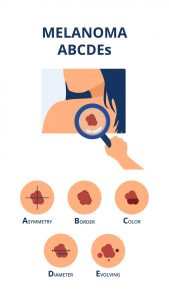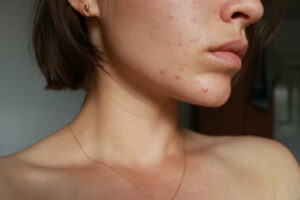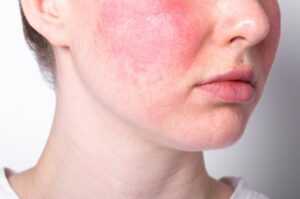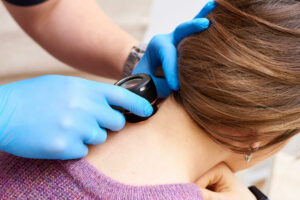Skin Cancer is the most common cancer in the United States. It’s one of the easiest to detect and prevent. As Californians gear up for the summer season, Golden State Dermatology reminds you to “slip, slop, slap and wrap” — slip on a shirt, slop on sunscreen (SPF 30 or higher), slap on a hat, and wrap on some UV-protective sunglasses!
What Is Skin Cancer?
According to the Skin Cancer Foundation, Skin cancer is the out-of-control growth of abnormal cells in the epidermis, the outermost skin layer, caused by unrepaired DNA damage that triggers mutations. These mutations lead the skin cells to multiply rapidly and form malignant tumors.
Basal cell carcinoma frequently appears on parts of the body that are most likely exposed, such as the head and neck, shoulders, back, or extremities. Patients with fair skin, blonde or red hair, and blue or green eyes are at the greatest risk of developing basal cell carcinoma.
Squamous cell carcinoma is most common in areas of the body that are frequently exposed to the sun. However, this type of tumor can occur on other parts of the body as well. Warning signs of squamous cell carcinoma include a wart-like growth or a scaly red patch, an open, non-healing sore, or an elevated growth. These lesions can occasionally bleed or crust over and may have borders that are difficult to define.
Melanoma, the third most common type of skin cancer, begins in the melanocytes. Of all types of skin cancer, melanoma causes the most deaths because of its tendency to spread to other parts of the body, including vital organs. Malignant melanoma is the deadliest of all skin cancers.
What Causes Skin Cancer?
The two main causes of skin cancer are the sun’s harmful ultraviolet (UV) rays and the use of UV tanning beds. If skin cancer is caught early, your dermatologist can treat it with little or no scarring and high odds of eliminating it entirely. Often, your dermatologist may detect the growth at a precancerous stage, before it has become a full-blown skin cancer or penetrated below the surface of the skin.
What should I look for?
When checking your moles, marks and other skin irregularities consider this handy way to remember these features.
Think of the A, B, C, D, and E of skin cancer.

A = Asymmetry is when one half of the growth looks different than the other half
B = Borders that are irregular
C = Color changes or more than one color
D = Diameter greater than the size of a pencil eraser
E = Evolving is when there are changes in size, shape, symptoms (itching, tenderness), surface (especially bleeding) or shades of color
How can I protect myself?
It’s important that you perform a full-body self-exam monthly and visit your GSD dermatologist once a year for a skin check.
You can protect your skin by:
- Limiting your time in the sun, staying in shady areas and using an umbrella
- Avoiding tanning beds
- Use sunscreen with SPF 30 or higher, at least 15 minutes before going outside and reapplying every two hours
- Wearing protective clothing
- Wearing wide-brimmed hat and sunglasses to protect your face and neck
- Always check the UV index! Remember, UV rays are most dangerous between 10am-4pm as well as near water, snow, and sand because the rays reflect from the ground.
Make your skin health a priority, book an appointment online today by clicking here.






